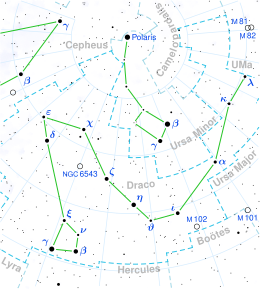Alruba
| Observation data Epoch J2000.0 Equinox J2000.0 | |
|---|---|
| Constellation | Draco |
| Pronunciation | /ælˈruːbə/ |
| Right ascension | 17h 43m 59.17049s[1] |
| Declination | +54° 48′ 06.1637″[1] |
| Apparent magnitude (V) | 5.76[2] |
| Characteristics | |
| Evolutionary stage | Main sequence[3] |
| Spectral type | A0V[4] |
| Astrometry | |
| Radial velocity (Rv) | −2.0[5] km/s |
| Proper motion (μ) | RA: 17.450[1] mas/yr Dec.: −18.125[1] mas/yr |
| Parallax (π) | 7.1436 ± 0.0605 mas[1] |
| Distance | 457 ± 4 ly (140 ± 1 pc) |
| Details | |
| Mass | 2.97±0.07[3] M☉ |
| Luminosity | 146.7+29.6 −24.7[3] L☉ |
| Surface gravity (log g) | 3.80±0.10[6] cgs |
| Temperature | 9,226+107 −106[3] K |
| Metallicity [Fe/H] | −0.40±0.11[6] dex |
| Rotational velocity (v sin i) | 170[3] km/s |
| Age | 58[7] Myr |
| Other designations | |
| Database references | |
| SIMBAD | data |
Alruba,[9] a name derived from Arabic for "the foal", is a suspected astrometric binary[10] star system in the northern circumpolar constellation of Draco. It is just barely visible to the naked eye as a dim point of light with an apparent visual magnitude of 5.76.[2] Based on parallax measurements obtained during the Gaia mission, it is located at a distance of about 457 light-years (140 parsecs) from the Sun. The system is drifting closer with a radial velocity of −2 km/s.[5]
The visible component is an A-type main-sequence star with a stellar classification of A0 V.[4] It is about 58[7] million years old with three[3] times the mass of the Sun and has a high rate of spin, showing a projected rotational velocity of 170 km/s.[3] The star is radiating 147[3] times the luminosity of the Sun from its photosphere at an effective temperature of 9,226 K.[3] The system is a source for X-ray emission, which is most likely coming from the unseen companion.[11]
Nomenclature
[edit]In the Henry Draper catalogue this system has the designation HD 161693, while it has the identifier HR 6618 in the Bright Star Catalogue.[8]
It bore the traditional Arabic name الربع Al Rubaʽ "the foal" (specifically a young camel born in the spring), a member of the Mother Camels asterism in early Arabic astronomy.[12][13]
In 2016, the International Astronomical Union organized a Working Group on Star Names (WGSN)[14] to catalogue and standardize proper names for stars. The WGSN approved the name Alruba for this star on 1 June 2018 and it is now so entered on the List of IAU-approved Star Names.[9]
References
[edit]- ^ a b c d e Brown, A. G. A.; et al. (Gaia collaboration) (August 2018). "Gaia Data Release 2: Summary of the contents and survey properties". Astronomy & Astrophysics. 616. A1. arXiv:1804.09365. Bibcode:2018A&A...616A...1G. doi:10.1051/0004-6361/201833051. Gaia DR2 record for this source at VizieR.
- ^ a b Oja, T. (March 1985), "UBV photometry of stars whose positions are accurately known. II", Astronomy and Astrophysics Supplement Series, 59: 461–464, Bibcode:1985A&AS...59..461O.
- ^ a b c d e f g h i Zorec, J.; Royer, F. (2012), "Rotational velocities of A-type stars. IV. Evolution of rotational velocities", Astronomy & Astrophysics, 537: A120, arXiv:1201.2052, Bibcode:2012A&A...537A.120Z, doi:10.1051/0004-6361/201117691, S2CID 55586789.
- ^ a b Abt, Helmut A.; Morrell, Nidia I. (1995), "The Relation between Rotational Velocities and Spectral Peculiarities among A-Type Stars", The Astrophysical Journal Supplement Series, 99: 135, Bibcode:1995ApJS...99..135A, doi:10.1086/192182.
- ^ a b Gontcharov, G. A. (2006), "Pulkovo Compilation of Radial Velocities for 35 495 Hipparcos stars in a common system", Astronomy Letters, 32 (11): 759–771, arXiv:1606.08053, Bibcode:2006AstL...32..759G, doi:10.1134/S1063773706110065, S2CID 119231169.
- ^ a b Wu, Yue; et al. (2010), "Coudé-feed stellar spectral library – atmospheric parameters", Astronomy & Astrophysics, 525: A71, arXiv:1009.1491, Bibcode:2011A&A...525A..71W, doi:10.1051/0004-6361/201015014, S2CID 53480665.
- ^ a b Gullikson, Kevin; et al. (2016), "The Close Companion Mass-Ratio Distribution of Intermediate-Mass Stars", The Astronomical Journal, 152 (2): 40, arXiv:1604.06456, Bibcode:2016AJ....152...40G, doi:10.3847/0004-6256/152/2/40, S2CID 119179065.
- ^ a b "HD 161693 -- Star", SIMBAD Astronomical Database, Centre de Données astronomiques de Strasbourg, retrieved 2018-07-01.
- ^ a b Naming Stars, IAU.org, retrieved 2018-07-01.
- ^ Eggleton, P. P.; Tokovinin, A. A. (September 2008), "A catalogue of multiplicity among bright stellar systems", Monthly Notices of the Royal Astronomical Society, 389 (2): 869–879, arXiv:0806.2878, Bibcode:2008MNRAS.389..869E, doi:10.1111/j.1365-2966.2008.13596.x, S2CID 14878976.
- ^ Schröder, C.; Schmitt, J. H. M. M. (November 2007), "X-ray emission from A-type stars", Astronomy and Astrophysics, 475 (2): 677–684, Bibcode:2007A&A...475..677S, doi:10.1051/0004-6361:20077429.
- ^ Allen, R. H. (1963), Star Names: Their Lore and Meaning (rep. ed.), New York, NY: Dover Publications Inc., pp. 207–212, ISBN 0-486-21079-0, retrieved 2020-01-07.
- ^ Garfinkle, Robert A. (2008), Star-Hopping: Your Visa to Viewing the Universe (2nd ed.), Cambridge University Press, p. 183, ISBN 978-0521598897.
- ^ "International Astronomical Union | IAU", www.iau.org, retrieved 2018-07-01.

